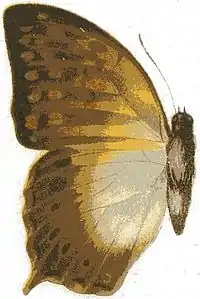Charaxes fulvescens
Charaxes fulvescens, the forest pearl charaxes, is a butterfly in the family Nymphalidae.
| Charaxes fulvescens | |
|---|---|
 | |
| Charaxes fulvescens, upperside | |
| Scientific classification | |
| Kingdom: | Animalia |
| Phylum: | Arthropoda |
| Class: | Insecta |
| Order: | Lepidoptera |
| Family: | Nymphalidae |
| Genus: | Charaxes |
| Species: | C. fulvescens |
| Binomial name | |
| Charaxes fulvescens (Aurivillius, 1891)[1] | |
| Synonyms | |
| |
Taxonomy
Charaxes varanes group. Subgenus Stonehamia (Hadrodontes) The group members are:
- Charaxes varanes
- Charaxes fulvescens very similar to varanes
- Charaxes acuminatus very pointed forewing
- Charaxes balfouri
- Charaxes analava
- Charaxes nicati
- Charaxes bertrami perhaps subspecies of varanes
- Charaxes saperanus
- Charaxes defulvata
Subspecies
Subspecies include:[1]
- Charaxes fulvescens fulvescens (eastern Nigeria, Cameroon, Gabon, Congo, Central African Republic, Democratic Republic of the Congo)
- Charaxes fulvescens imenti Plantrou, 1989 (central Kenya)
- Charaxes fulvescens marialuisae Canu, 1989 (Bioko)
- Charaxes fulvescens monitor Rothschild, 1900 (Central African Republic, southern Sudan, eastern Democratic Republic of the Congo, Uganda, Rwanda, Burundi, western Kenya, north-western Tanzania, north-western Zambia)
- Charaxes fulvescens senegala van Someren, 1975 (Senegal, Guinea-Bissau, Guinea, Sierra Leone, Liberia, Ivory Coast, Ghana, Togo, Benin, western Nigeria)
Distribution

This species is found in Senegal, Guinea-Bissau, Guinea, Sierra Leone, Liberia, Ivory Coast, Ghana, Togo, Benin, Nigeria, Cameroon, Equatorial Guinea, Gabon, the Republic of the Congo, the Central African Republic, the Democratic Republic of the Congo, Sudan, Uganda, Rwanda, Burundi, Kenya, Tanzania and Zambia.[1][2]
Habitat
These butterflies occurs in dense evergreen forests at low to moderate altitudes. Occasionally inhabits savanna.[2]
Description
Charaxes fulvescens can reach a wingspan of about 46 millimetres (1.8 in).[3] The inner half of the wings is white. Outside the white area of the upperside, the wings are orange to brown, with a pattern of lighter and darker flecks. The underside of the wings mimics a dead leaf. A sepia brown straight line divides the under wing in two areas. The inner area is light beige with several curved, interrupted, grey brown wavy lines. The outer area of the underside of the hindwing has a large eyespot and shows a well developed outer spur. Males and females are similar.[4]
Biology
The larvae feed on Allophylus species, including A. macrobothrys, A. africanus, A. macrostachys and A. subcoriaceus.[1][2] Males of these butterflies usually aggregate at mammalian dung for obtaining salts. Courtship and copulation generally take place at hilltops.[4]
References
| Wikimedia Commons has media related to Charaxes fulvescens. |
| Wikispecies has information related to Charaxes fulvescens. |
- "Charaxes Ochsenheimer, 1816" at Markku Savela's Lepidoptera and Some Other Life Forms
- Afrotropical Butterflies: File H - Charaxinae - Tribe Charaxini
- Butterflies of West Africa
- Learn about butterflies.
- Victor Gurney Logan Van Someren (1963). Revisional notes on African Charaxes (Lepidoptera: Nymphalidae). Part I. Bulletin of the British Museum (Natural History) (Entomology) 195-242.
External links
- Charaxes fulvescens maesseni images at Consortium for the Barcode of Life
- Charaxes fulvescens marialuisae images at BOLD
- Charaxes fulvescens monitor images at BOLD
- Images of C. fulvescens monitor Royal Museum for Central Africa (Albertine Rift Project)